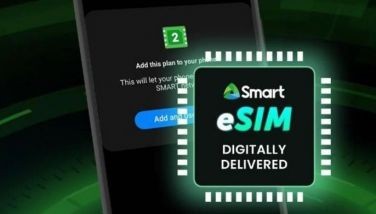‘Human technology’ key to Nokia’s new strategies
August 13, 2005 | 12:00am
Nokia is making a conscious effort to bring back the human touch into its products and is pushing marketing programs to make itself an even more attractive brand.
Ranked as the world’s sixth most valuable brand this year, Nokia has launched its newest line of handsets, highlighting new and more mature technologies designed to make communications as natural as possible.
From sponsoring public events to teach users how to configure the e-mail client on their phones to transforming Nokia stores to make them more inviting, the Finnish mobile phone maker is determined to make true its slogan of "connecting people."
With new high-performance multimedia handsets, Nokia offers users more options to send and receive instant information in different forms so they can be more connected with one another. In addition, Nokia is readying its handsets that will support Mobile TV and Visual Radio, which are expected to become commercial services in key cities around the world by 2006.
Mobile TV and Visual Radio give a new dimension to Nokia’s catchphrase of being "entertained anywhere." Mobile TV gives handsets the ability to receive television-like content from TV networks. The content can vary from news bulletins to market updates to the latest soaps or sports events.
Rhomel Marcojos, Nokia Philippines’ product manager for enterprise solutions, says television is the next step in the series of multimedia-rich functions to reach telephony. However, Mobile TV won’t be taking off unless networks and content providers agree to push it.
The technology used for Mobile TV is called IP Datacasting over DVB-H (Digital Video Broadcast for Handheld). It is essentially a combination of digital broadcasting over IP (Internet Protocol) to enable service reception in handheld devices. Handsets require an additional radio receiver, which is separate from the cellular receiver, to receive a signal. The DVB-H receiver is integrated in a similar manner as Bluetooth receivers in mobile phones. The system operates separately from GSM or 3G services as users would receive content as it happens – like normal TV – as opposed to on-demand.
Making TV content available on a mobile phone means bringing familiar and popular content to people wherever they are. A recent survey conducted by BMCO (Broadcast Mobile Convergence) in Berlin, Germany found that 80 percent of people would be interested in the idea of accessing TV via their mobile phones and would pay for such a service.
For TV companies, the benefits of reusing popular content and having new distribution platform mean additional revenue opportunities. Of course, they can also develop new content specifically made for mobile TV. For advertisers, mobile TV brings an additional outlet for communicating brand messages. Mobile operators, on the other hand, get new opportunities to grow their interactive services and drive data business.
Mobile TV was first tested on the Nokia 7700 with TV reception coming from a battery accessory called Nokia Streamer (the DVB-H receiver). Easily 50 digital TV stations can be supported in a mobile device with video quality of 30 frames per second as good as what TV offers.
Nokia’s first Mobile TV device will be based on its Series 60 platform and will be commercially available in 2006, says Marcojos.
Mobile TV services have been introduced in Japan, the United States and Europe. Last year, Nokia, together with MediaCorp. Technologies, M1 and the Media Development Authority of Singapore, piloted Asia Pacific’s first live end-to-end mobile phone TV broadcast over DVB-H datacasting technology.
Visual Radio, on the other hand, redefines the mobile FM radio experience not just for listeners but also for radio stations, advertisers and operators. With Visual Radio, images and text are synchronized with the radio broadcast to bring information and interactivity directly to the mobile phone. Visual Radio offers greater access to factual content and turns passive radio listeners into active ones by letting them use their handsets to participate in real-time radio polls or buy products advertised on the Visual Radio program. Visual Radio makes use of the handset’s FM receiver and is over the GPRS mobile network.
The Nokia 7710 and Nokia 3230 were Nokia’s first Virtual Radio enabled handsets. Nokia executives project Visual Radio-enabled handsets installation to reach 100 million units next year.
The Finnish Kiss FM is the first radio station in the world to have Visual Radio channels. The first operator to offer Visual Radio is TeliaSonera in Finland. In Asia, Nokia, together with HP, MediaCorp. Radio and Starhub, launched last year a pilot program on Visual Radio in Singapore.
For a company that holds 33 percent of the handset market and has just sold its one-billionth mobile device last quarter, Nokia needs to keep its current market and find new ones.
Instead of just going back to the same old well, Nokia is finding new sources of revenues, too, from the D and E markets and from second- and third-tier cities around the country, says Parikshit Bhasin, country general manager of Nokia Philippines.
Bhasin says these market segments provide the industry with new subscribers. However, he admits Metro Manila will continue to bring in the largest sales percentage for Nokia as it has the highest concentration of people with better buying power.
Overall, Nokia registered a sales growth of 25 percent year-on-year during the second quarter, and a 34 percent increase in its mobile device up-take. To keep these numbers up, Bhasin says Nokia will concentrate on three things: volume advantage, quality, and broad presence.
After-market service has also become a differentiator, Bhasin adds, so they launched the Nokia Mobility Plus to give free tutorials to Nokia users on certain subjects such as configuring their Nokia mobile phones to access mobile e-mail, using the Nokia PC Suite, and printing photos using their Nokia imaging phone and a compatible printer.
The Nokia Mobility Plus is a monthly public event held in select locations around the country with the objective of showing users the value-for-money features of their Nokia phones, adds Marcojos.
"We didn’t really conduct a formal study on end-user behavior (on this one). But we did get the feeling that many end-users have not been able to maximize the use of their feature-rich Nokia phones. Thus, we decided to introduce Nokia Mobility Plus, which is a purely educational and awareness program implemented, at the moment, only in the Philippines although we will share our learnings with other countries," explains Marcojos.
Nokia is also giving its stores a make-over to replace the cold and technical character of telecom shops with a more relaxing atmosphere where buyers can really test the new phones, says Gerard Yusay, retail and distribution head of Nokia Philippines.
"The new shops will have competent staff to assist buyers and dedicated areas for consultation... We have a rollout plan in place and the new look will be initially implemented for the new stores. The existing stores will follow as per the rollout plan," Yusay says.
In addition, Nokia just launched the Nokia Elite clearly to increase its customer and brand appeal. The Nokia Elite is an exclusive membership program for owners of the Nokia Communicator 9500, 9300, 8800 and soon the N90. Members get to enjoy exclusive discounts in different commercial establishments, access to Nokia’s Mobility Plus tutorials and other premium care services.
So far, demand for Nokia 9500 has exceeded the local Nokia office’s expectations, says Marcojos, who adds that the Philippines ranked third in volume for Nokia 9500 in the Asia-Pacific last year. "Many are using it for personal and business use. Corporations are using it as an enterprise device for their sales force and management executives," he adds.
Nokia has launched 34 new products in the last six months, 12 of which have made their way into the Philippines. Designed for different segments of the market, the new batch of handsets include the first of Nokia Nseries multimedia handsets – N90, N91, N70 – and the basic Nokia 1110 and Nokia 1600 for first-time users.
Although worlds apart in terms of looks and functionalities, the premium Nseries and the new entry-level handsets both exhibit unique features that address intrinsic human needs. The Nokia Nseries caters to those who want a do-it-all phone. It’s a single device for snapping print-quality images, reading e-mail, listening to music, browsing websites and watching mobile TV, among others.
"The Nseries was launched in Kuala Lumpur last April and now it’s here. It’s a Nokia sub-brand for high-performance multimedia phones that are iconic in design with high specifications," says Mike Smith, Nokia Philippines product manager for multimedia phones.
Because Nokia Nseries is based on the Series 60 platform, Smith says users can choose from thousands of add-on applications to customize their device in a way that would best suit their needs.
On the other hand, Nokia also kept in mind the needs of many first-time handset users when it designed the Nokia 1110 and Nokia 1600. These two models sport a new intuitive user interface that makes full use of graphical icons and large font sizes. Anabelle Co, Nokia Philippines’ product manager for classic mobile phones, says the large font feature has had good user reviews, not to mention its unique Filipino-English predictive text feature specially developed for the text capital of the world.
Both Nokia phones also have a distinct messaging feature of write now, send later so users can choose when it’s best to send out their messages. The units also feature a Text Message Counter (for load budgeting) and a Text Screening feature that will filter messages from numbers that the user has barred.
Meanwhile, Nokia foresees that over half a billion people in the world will own a camera phone this year. Bhasin says this means a growth of over four times than the digital camera market. Nokia is now the world’s largest manufacturer of digital camera, music players and handheld computer, he adds.
Nokia alone expects to sell close to 100 million of its camera phones this year. In the Philippines, the most affordable Nokia camera phones are the Nokia 3200 and the Nokia 6610i which sell at a little over P6,000.
Why camera phones are so popular is no mystery. People know that a picture can say a thousand words, which are more than the 900 characters that one can type in one message using the new Nokia 1110 or 1600.
Ranked as the world’s sixth most valuable brand this year, Nokia has launched its newest line of handsets, highlighting new and more mature technologies designed to make communications as natural as possible.
From sponsoring public events to teach users how to configure the e-mail client on their phones to transforming Nokia stores to make them more inviting, the Finnish mobile phone maker is determined to make true its slogan of "connecting people."
With new high-performance multimedia handsets, Nokia offers users more options to send and receive instant information in different forms so they can be more connected with one another. In addition, Nokia is readying its handsets that will support Mobile TV and Visual Radio, which are expected to become commercial services in key cities around the world by 2006.
Rhomel Marcojos, Nokia Philippines’ product manager for enterprise solutions, says television is the next step in the series of multimedia-rich functions to reach telephony. However, Mobile TV won’t be taking off unless networks and content providers agree to push it.
The technology used for Mobile TV is called IP Datacasting over DVB-H (Digital Video Broadcast for Handheld). It is essentially a combination of digital broadcasting over IP (Internet Protocol) to enable service reception in handheld devices. Handsets require an additional radio receiver, which is separate from the cellular receiver, to receive a signal. The DVB-H receiver is integrated in a similar manner as Bluetooth receivers in mobile phones. The system operates separately from GSM or 3G services as users would receive content as it happens – like normal TV – as opposed to on-demand.
Making TV content available on a mobile phone means bringing familiar and popular content to people wherever they are. A recent survey conducted by BMCO (Broadcast Mobile Convergence) in Berlin, Germany found that 80 percent of people would be interested in the idea of accessing TV via their mobile phones and would pay for such a service.
For TV companies, the benefits of reusing popular content and having new distribution platform mean additional revenue opportunities. Of course, they can also develop new content specifically made for mobile TV. For advertisers, mobile TV brings an additional outlet for communicating brand messages. Mobile operators, on the other hand, get new opportunities to grow their interactive services and drive data business.
Mobile TV was first tested on the Nokia 7700 with TV reception coming from a battery accessory called Nokia Streamer (the DVB-H receiver). Easily 50 digital TV stations can be supported in a mobile device with video quality of 30 frames per second as good as what TV offers.
Nokia’s first Mobile TV device will be based on its Series 60 platform and will be commercially available in 2006, says Marcojos.
Mobile TV services have been introduced in Japan, the United States and Europe. Last year, Nokia, together with MediaCorp. Technologies, M1 and the Media Development Authority of Singapore, piloted Asia Pacific’s first live end-to-end mobile phone TV broadcast over DVB-H datacasting technology.
Visual Radio, on the other hand, redefines the mobile FM radio experience not just for listeners but also for radio stations, advertisers and operators. With Visual Radio, images and text are synchronized with the radio broadcast to bring information and interactivity directly to the mobile phone. Visual Radio offers greater access to factual content and turns passive radio listeners into active ones by letting them use their handsets to participate in real-time radio polls or buy products advertised on the Visual Radio program. Visual Radio makes use of the handset’s FM receiver and is over the GPRS mobile network.
The Nokia 7710 and Nokia 3230 were Nokia’s first Virtual Radio enabled handsets. Nokia executives project Visual Radio-enabled handsets installation to reach 100 million units next year.
The Finnish Kiss FM is the first radio station in the world to have Visual Radio channels. The first operator to offer Visual Radio is TeliaSonera in Finland. In Asia, Nokia, together with HP, MediaCorp. Radio and Starhub, launched last year a pilot program on Visual Radio in Singapore.
Instead of just going back to the same old well, Nokia is finding new sources of revenues, too, from the D and E markets and from second- and third-tier cities around the country, says Parikshit Bhasin, country general manager of Nokia Philippines.
Bhasin says these market segments provide the industry with new subscribers. However, he admits Metro Manila will continue to bring in the largest sales percentage for Nokia as it has the highest concentration of people with better buying power.
Overall, Nokia registered a sales growth of 25 percent year-on-year during the second quarter, and a 34 percent increase in its mobile device up-take. To keep these numbers up, Bhasin says Nokia will concentrate on three things: volume advantage, quality, and broad presence.
After-market service has also become a differentiator, Bhasin adds, so they launched the Nokia Mobility Plus to give free tutorials to Nokia users on certain subjects such as configuring their Nokia mobile phones to access mobile e-mail, using the Nokia PC Suite, and printing photos using their Nokia imaging phone and a compatible printer.
The Nokia Mobility Plus is a monthly public event held in select locations around the country with the objective of showing users the value-for-money features of their Nokia phones, adds Marcojos.
"We didn’t really conduct a formal study on end-user behavior (on this one). But we did get the feeling that many end-users have not been able to maximize the use of their feature-rich Nokia phones. Thus, we decided to introduce Nokia Mobility Plus, which is a purely educational and awareness program implemented, at the moment, only in the Philippines although we will share our learnings with other countries," explains Marcojos.
Nokia is also giving its stores a make-over to replace the cold and technical character of telecom shops with a more relaxing atmosphere where buyers can really test the new phones, says Gerard Yusay, retail and distribution head of Nokia Philippines.
"The new shops will have competent staff to assist buyers and dedicated areas for consultation... We have a rollout plan in place and the new look will be initially implemented for the new stores. The existing stores will follow as per the rollout plan," Yusay says.
In addition, Nokia just launched the Nokia Elite clearly to increase its customer and brand appeal. The Nokia Elite is an exclusive membership program for owners of the Nokia Communicator 9500, 9300, 8800 and soon the N90. Members get to enjoy exclusive discounts in different commercial establishments, access to Nokia’s Mobility Plus tutorials and other premium care services.
So far, demand for Nokia 9500 has exceeded the local Nokia office’s expectations, says Marcojos, who adds that the Philippines ranked third in volume for Nokia 9500 in the Asia-Pacific last year. "Many are using it for personal and business use. Corporations are using it as an enterprise device for their sales force and management executives," he adds.
Although worlds apart in terms of looks and functionalities, the premium Nseries and the new entry-level handsets both exhibit unique features that address intrinsic human needs. The Nokia Nseries caters to those who want a do-it-all phone. It’s a single device for snapping print-quality images, reading e-mail, listening to music, browsing websites and watching mobile TV, among others.
"The Nseries was launched in Kuala Lumpur last April and now it’s here. It’s a Nokia sub-brand for high-performance multimedia phones that are iconic in design with high specifications," says Mike Smith, Nokia Philippines product manager for multimedia phones.
Because Nokia Nseries is based on the Series 60 platform, Smith says users can choose from thousands of add-on applications to customize their device in a way that would best suit their needs.
On the other hand, Nokia also kept in mind the needs of many first-time handset users when it designed the Nokia 1110 and Nokia 1600. These two models sport a new intuitive user interface that makes full use of graphical icons and large font sizes. Anabelle Co, Nokia Philippines’ product manager for classic mobile phones, says the large font feature has had good user reviews, not to mention its unique Filipino-English predictive text feature specially developed for the text capital of the world.
Both Nokia phones also have a distinct messaging feature of write now, send later so users can choose when it’s best to send out their messages. The units also feature a Text Message Counter (for load budgeting) and a Text Screening feature that will filter messages from numbers that the user has barred.
Meanwhile, Nokia foresees that over half a billion people in the world will own a camera phone this year. Bhasin says this means a growth of over four times than the digital camera market. Nokia is now the world’s largest manufacturer of digital camera, music players and handheld computer, he adds.
Nokia alone expects to sell close to 100 million of its camera phones this year. In the Philippines, the most affordable Nokia camera phones are the Nokia 3200 and the Nokia 6610i which sell at a little over P6,000.
Why camera phones are so popular is no mystery. People know that a picture can say a thousand words, which are more than the 900 characters that one can type in one message using the new Nokia 1110 or 1600.
BrandSpace Articles
<
>
- Latest
Latest
Latest
December 28, 2023 - 12:00am
December 28, 2023 - 12:00am
December 11, 2023 - 11:00am
December 11, 2023 - 11:00am
November 23, 2023 - 4:35pm
November 23, 2023 - 4:35pm
October 16, 2023 - 5:00pm
October 16, 2023 - 5:00pm
August 24, 2023 - 4:43pm
August 24, 2023 - 4:43pm
Recommended






























